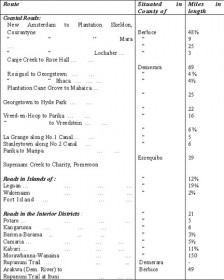Road and rail transport
Guyana has always been a challenging territory to traverse. Decades ago, the colonial administration devised a public road, river and rail transport system to overcome this challenge. Guyana Review reprints a section of The British Guiana Handbook, 1922 which describes how road and rail transportation functioned over eighty years ago.
Road
The roads of the Colony (other than Municipal) may be classified in three groups, viz:
(a) Main roads, comprising those running more or less parallel with the coast from Coverden on the East Bank of the Demerara River to Rosignol and Blairmont on the West Bank of the Berbice River, a distance of 89 miles; from Vreedstein on the West Bank of the Demerara River to Maripa on the East Bank of the Essequibo River, a distance of 44 miles; from Supenaam on the West Bank of the Essequibo to Charity on the East Bank of the Pomeroon River, a distance of 39 miles; and from Mara on the West Bank of the Berbice River to Skeldon on the West Bank of the Courantyne River, a distance of 73½ miles; and 32 miles of roads in the islands of Wakenaam and Leguan.
(b) Branch Roads, comprising:
(1) Approaches to railway stations, steamer stellings, etc.
(2) Roads along the banks of the Mahaica, Mahaicony and Canje Creeks, the West Bank of the Berbice River and the Nos. 1, 2 and 3 Canal roads off the Demerara River.
(3) Seawall and military roads in Georgetown outside the municipal boundaries.
(c) Villages and estate roads, forming the connection to villages and estates from the main and branch roads.
Classes (a) and (b) are maintained from general revenue, no special taxation being levied for their upkeep. Class (c) are maintained by the Local Authorities of the Villages under the auspices of the Local Government Board and the expenditure on this and other works such as drainage, sanitation, water supply, etc., is met from rates levied on owners of property in those villages.
The public roads of the Colony are being gradually extended with a view to opening up districts which offer scope for development and giving service where most needed.
The Cattle trail with outlets at Takama, 108 miles from the mouth of the Berbice River, and Arakwa 64 miles from the mouth of the Demerara River and running for 150 miles to Annai in the Rupununi District − serving the great cattle country on the intermediate and hinterland savannahs and providing a direct means of access to the frontier of Brazil − is a big step forward in the opening up of the interior. When this trail is linked up with Georgetown from which the Southern road at present extends along the East Bank of the Demerara River as far as Hyde Park (23 ½ miles), it will be practicable to travel on horseback and, it is hoped ultimately, by motor-car, from the capital of the Colony to the great grass savannahs extending down to the Southern frontier bordering on Brazil.
Another valuable piece of work is in hand − the completion the Kangaruma Road branching off the Potaro Road − which will be a great advantage in this mining district and a step towards road communication to Kaieteur Fall.
New roadways are also being opened up in the North-West District, the section of 12 miles from Morawhanna to Wanaina Creek is built as the first step towards opening up hilly country which is more readily accessible from the coast in that part of the Colony than in other districts and is considered suitable for settlers.
This summary is by no means exhaustive and projects are in hand for the better linking up of the diamond fields with the steamer terminus as well as for opening up other areas which are difficult of access.
List of principal roads with situation and mileage
 Public transportation facilities to the different parts of the Colony are handled by the Government through the Colonial Transport Department and by Messrs. Sprostons, Ltd., as contractors to the Government.
Public transportation facilities to the different parts of the Colony are handled by the Government through the Colonial Transport Department and by Messrs. Sprostons, Ltd., as contractors to the Government.
The operations of the Colonial Transport Department extend at present along the coastal area from New Amsterdam on Berbice River, to Suddie and Pomeroon on the Essquibo coast and Bartica on the Essequibo River. Messrs. Sprostons’ services are carried on from Georgetown and New Amsterdam up the rivers towards the interior with one costal service to Morawhanna in the North West District. The Government services come under three heads, Rail Ferry and Steamship, all working into one another.
[Rail]
The most recent acquisition by the Government is the railways operating from Georgetown to Rosignol − 60½ miles Eastward along the coast − and from Vreed-en-Hoop on the West Bank of the Demerara River to Parika − a distance of 18½ miles. Since the passing of control of these railways from the Demerara Railway Company to the Colonial Transport Department, a great deal has been done to improve the service and greatly increased facilities are given to the public as regards both freight and passenger traffic. The Demerara Railway is reputed to be the oldest in South America.
On the East Coast, the Berbice trains leave Georgetown (the city) every weekday at 8 a.m. for Rosignol – 60½ miles – the terminus on the left bank at the mouth of the Berbice River, connecting with the ferry steamer to the Town of New Amsterdam.
On the West Coast, the trains leave Vreed-en-Hoop, the West Bank of the Demerara River, three times a day after the arrival of the Demerara River ferry steamer for Parika – 18½ miles – the terminus on the right bank of the Essequibo River and the connecting point with the steamer on the Bartica route, Adventure route, Supenaam route and Essequibo ferry.

